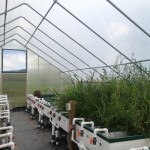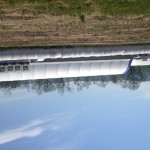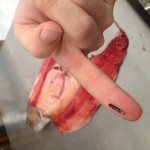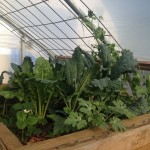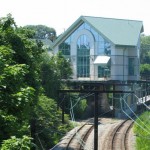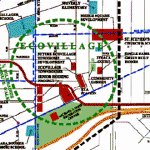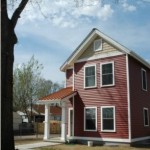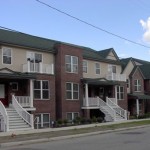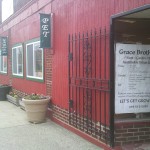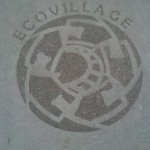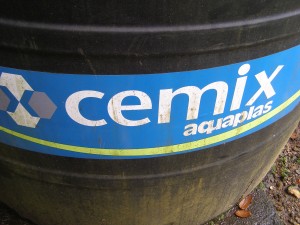|
|
I am stationed at the Detroit Shoreway Community Development Office (DSCDO) off Detroit Avenue and W. 65th Street to better acquaint myself with the community. The DS Community Organizer gave me a tour of the EcoVillage and neighborhood, during the tour a construction manager gave us an impromptu tour of one of his newly completed townhomes that are built in correspondence with the DSCDO tio increase the critical mass.
While back in the office, I am working through two file drawers of EcoVillage paperwork to create a workbook. After work during this week, a CEO of a local business whom I discussed the project to emphasized that this material needs to be understandable and relative to the community members.
One of the key EcoVillage materials is a Design Charette that is based on feedback from community members on what they want to see in the EcoVillage. The results were: (1) Green Buildings (2) Urban Agriculture & Greenspace (3) Transit-Oriented Development (4) Societal Independence. Based on this, I made a brochure/flyer/mailer using the green terms in the design charette. A later version is translated for all of the community.
Please see the attached link. Detroit Shoreway EcoVillage_Brochure
Over the past week, I have been working at the Aquaculture Marketing and Product Development aquaponics and aquaculture project site at the WVU state extension farm in Wardensville, West Virginia. I am about halfway through my stay here and it has proved to be an amazing learning experience.
The farm is producing rainbow and golden trout in cold water, flow-through raceways which feed a deep water raft culture hydroponic greenhouse and a phytoremedation plant production pond. These features make the project here unlike any other one known in the world. Most aquaponic production consists of circulating systems where the water is reused many times over and depending on climate, generally produces warm water fish species. The cold water flow-through systems are interesting because the researchers here are testing conditions in which phytoremediation plants can be cultivated so that they remove close to all nutrients in the effluent water which has proven to be an important, natural way to remove pollutants from water bodies. Reclaimed mine water is also being used in one of the systems which has a very high mineral content and provides a productive system where outflow water from the mine water treatment plants can be used for production before it enters the watershed, allowing the abundance of minerals to be used for fish culture.
One of the most important aspects of the work done in aquaculture and aquaponics is studying and caring for the fish. Fish are frequently transported to and from Morgantown (where WVU is actually located), the USDA Agricultural Research Service National Cool and Cold Water Aquaculture center and the Wardensville farm. The USDA ARS performs genetic and disease resistance research on the fish and, after their use, must “get rid” of them somehow. By transporting them in the “fish hauler”, the associates from WVU and the extension service are granted a free fish source for their aquaculture and aquaponics projects and the fish usually end up getting donated to community members at the end of their life cycles. The USDA ARS primarily deals with trout species but I have spent many hours this past week hauling fish of many different species: trout, perch, carp, catfish and even sturgeon. I received a tour of the USDA ARS which was very interesting. The facility has millions of dollars worth of equipment and extensive research goes on there. In one of the pictures, you can see the identification implants that are put into the fish at the USDA ARS which must be taken out when the fish are being fileted to be donated.
To test my knowledge of operating an aquponics system, my supervisor charged me with the task of managing the small, backyard-sized system that is located in the greenhouse. I feed the fish everyday, check the water quality levels and add supplemental inputs to balance the pH. It has been a very valuable experience which has allowed me to analyze the changing conditions that must be dealt with in an aquaponics system.
The high tunnel (similar to a greenhouse) isn’t going to build itself, so I better get back to it!
Until next time…
I chose to start my internship in a place close to home- the City of Cleveland. The City of Cleveland’s administration is currently working on a sustainability mission that works to use ‘sustainability’ as an economic development goal and to help save the city money, see more here. The City of Cleveland’s Office of Sustainability Manager has chosen a Cleveland neighborhood to be a national demonstration project for an EcoDistrict. An EcoDistrict is a district that addresses issues of GHG emissions, other environmental health issues, affordability, sustainability building design, TOD, and more, see here. So, having a connection with the Cleveland Sustainability Manager, I couldn’t pass the opportunity up to apply my new found Master’s education here.Later on, I will see if I can do a follow up internship/study abroad based on the tools and knowledge I gain from this experience.
My internship kicked off with a meeting with the local Councilman, the Director of the Detroit-Shorway Community Development Organization, the then EcoVillage Coordinator, and several others working within the community development organizations on the EcoVillage. During the meeting, I shared my background and why I was here and what I thought I could contribute. They shared who they were and what their goals were moving forward. The DS Director and Councilman stated that first, they wanted a Workbook of all the EcoVillage files that had been kept since 1997 when the EcoVillage was initiated, then a map for a website that can communicate to the community what the EcoVillage is, and then an Implementation Plan. I agreed to the Workbook, the map for me with a Geography background was also reasonable, and I stated that I would prefer to create a Master Plan for the EcoVillage/ EcoDistrict. A comment from a former EcoVillage Manager early was that the EcoVillage needed to be legitimized, so I would rather supply a foundation for future Implementation Plans, and then if time permitting I would also include a series of development recommendations or Implementation Plans. My goal is to be able to create a ‘toolkit’ to evaluate an area’s ‘sustainability’ and then offer scientifically-based recommendations to build a community that meets the most ideal aspects of the triple-bottom line to also any community in the world.
KAYLA SINOTTE
Last week on the Island
My last week was eventful to say the least.. It was crunch time for us Permaculture students, we had to finalize our projects and prepare a presentation. My project for the National Organic Certification consisted of lengthy applications, for example the Organic Systems Plan and the Organic Livestock Plan. In addition i had to map the entire property and the parcel of land we were applying for certification. I had to complete several different layers to show the contours, different zones, energy sector analysis, existing structures, fields/gardens and ponds, Vegetation, and Livestock. While completing our individual projects, we still had to work everyday out in the fields and complete the harvest for our CSA Community Supported Agriculture commitments. It was a busy week, but it was amazing and my only regret is not being able to stay longer.
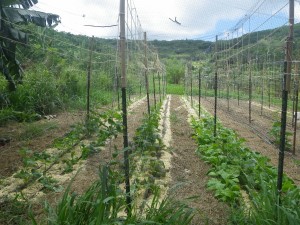 One of our Swale plots
Leaving the Islands
I just flew back to the States yesterday and let me tell you.. I never thought I would experience culture shock coming back to Florida. It amazes me how many unnecessary things people think they need. For the last seven weeks I have experienced living out in nature, with no doors, no windows, no a/c, or hot water. So to come back to Tampa, I almost feel slightly disgusted to see how much energy people waste, and how much people dont think about the food they put in their mouth. This experience has brought so much knowledge and deeper understanding of sustainable farming and living. I feel like I see everything in a much different light. I only wish i was still there..
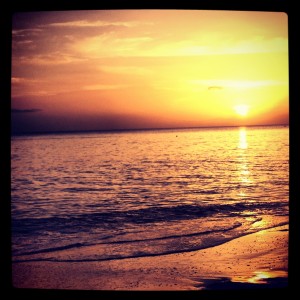 St. Croix Sunset
Panamanians love Croc sandals and water systems made from PVC pipe. I will purchase PVC pipe and all kinds of attachment pieces for a project I am building at a rural residence in Juan Gill, Panama, near where I stay in San Miguel.
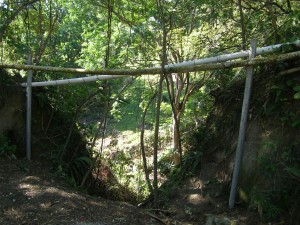 Somebody's water system...took this photo heading back into San Miguel after hiking to the valley at Tres Brazos. 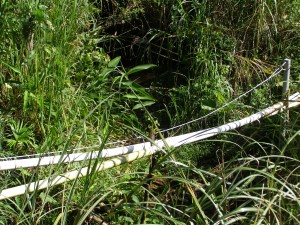 A suspension bridge built to protect the weight of PVC pipe carrying water across a ravine as it comes down the mountainside.
I love Panama because because the people and the land is beautiful. Panama is a place where mountains meet the sea, Pacific Ocean and Caribbbean Sea, and the lush tropical landscape is drained by thousands of arroyos and rivers. Water is everywhere but it is not always potable because of contamination. In rural areas without access to municipal water systems people have come up with some interesting ways of collecting and storing water.
This blog will showcase water systems I have seen during my time in this enchanting country. Mostly I have been looking at the water tanks they use to store water and figuring out where I can get the most affordable and largest tank for my project.
My final blog will show the steps of progress of my own water project, the rainwater collection system at Miriam’s house. The water tank was delivered Tuesday, we leveled the ground in the backyard, and started installing the foundation for the platform. Funny story about the tank delivery. Miriam and I were in the backyard working so hard we missed the truck when it came to deliver the tank. Nathan, Miriam’s grandson, was playing in the front yard and was supposed to be keeping an eye out but when I came up to the front of the house I saw the truck and tank disappearing down the road towards La Mesa away from the house. I told Miriam what happened and we tried calling the place where I ordered the tank from but we didn’t have their phone number. Miriam’s next move was to call the police and ask them to find the truck and turn it around. Pretty smart, the truck came back to us and the tank is in the yard ready to be installed. My last blog will tell you all about this project, it will be completed this week.
As promised, some water tank photos.
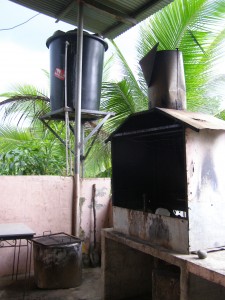 Water tank at the Taverna del Rio, the local pub in San Miguel. The Pacora River runs next to this establishment but they draw their water from arriba, or uphill on the mountaintops, through a PVC pipe that runs under the suspension bridge across the river and to this tank. 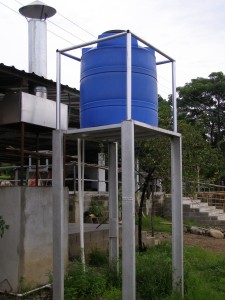 Water tank at the breakfast fonda across the street. Notice how both tanks are lifted off the ground on platforms so that gravity can draw water from the tank and no pump or electricity is needed. 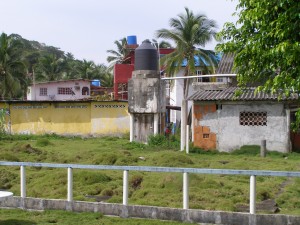 Water tanks for private residences on Isla Grande, a small island in the Caribbean Sea.
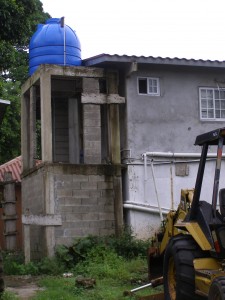 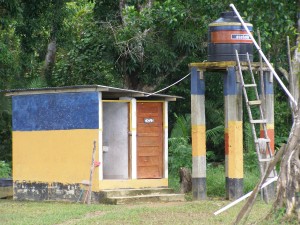
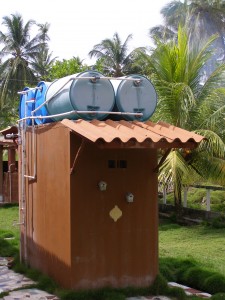
I stayed in a hostel in Portabelo, Panama, called Captain Jack’s that had a rainwater collection system. Dario, who keeps the place running when Captain Jack is busy taking people on catamaran cruises from Portabelo through the San Blas Islands to Colombia, told me that the water actually comes from two sources. They collect rainwater and draw water from a stream coming down the mountainside. Here is what their set-up looked like. These are the biggest plastic water cisterns I have seen in Panama.
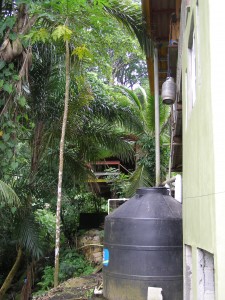 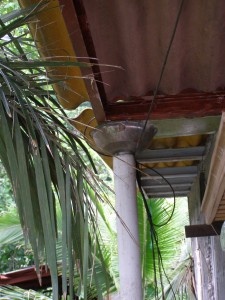
It’s been a week since the end of my time at the City of Markham Sustainability Office, and I’ve been visiting other sites in the area to provide both anchors and comparatives for my research. The work going on in the municipal office is important, but the greater context matters even more.
The first thing that jumps out is the prevalence of solar photovoltaic panels on residential, agricultural, and commercial buildings. Too often the uninformed public assumes solar energy is impractical at these latitudes, yet through outreach and education it is possible to change that mindset.
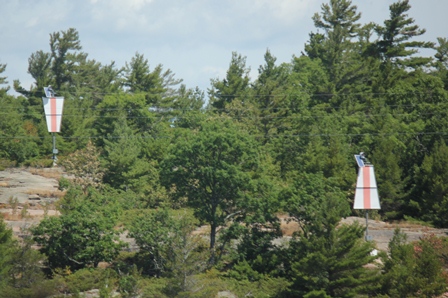 VAWT with solar pv - Georgian Bay While wind energy would also be viable in this area, it is far less common due to space constraints and concerns about safety. Smaller wind energy applications, such as the VAWTs pictured above, are gaining ground and could become a significant source of local energy. This growth would require a strong campaign to improve awareness of the options available to consumers.
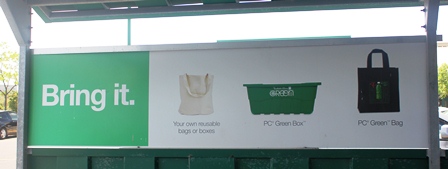 The parking lot sign at a local grocery. The use of reusable shopping containers is another facet of life in Ontario that stands out. While plastic bags remain available (for a fee), most shoppers own and use a variety of bags and bins. These containers are a frequent ‘giveaway’ item at festivals and outreach events, including from Markham’s Sustainability Office.
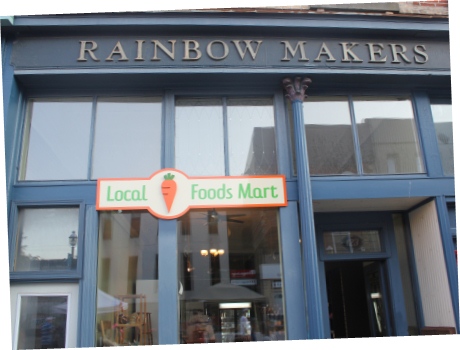 A local foods shop in Barrie While major grocery chains are still the go-to shopping choice, there is an ever-growing trend toward local food and the vendors that carry it. This is particularly evident in summer and autumn, when the ubiquitous farmers’ markets and roadside stands offer the best of what’s around at any given time. During these seasons suburbanites are reawakened to the bounty available from the farms and gardens all around them–the Greater Toronto Area (GTA) is built on some of the best agricultural land in the province, and borders the rest.
KAYLA SINOTTE
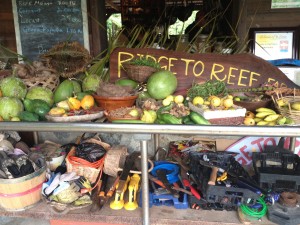 Ridge to Reef Farm Slow Down Dinner
Every once a month or so, the Farm will host a slow down dinner. It is a six course meal made from all organic locally grown food from the farm or neighbors. This donation based dinner helps bring the community together to share our wonderful food and bridge the education gap between the farmers and the locals.
 Butchered Lamb from the Farm
-
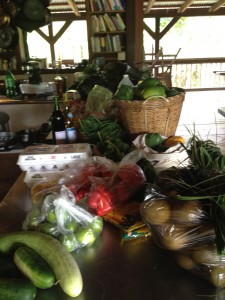 Locally grown food from the farm
Six Courses of Goodness
Each course is prepared by a legendary Chief from the Island and designed with care. The purpose of the slow down dinner is to take the time to not only enjoy the food you are eating but most importantly learn about each meal and the ingredients used. Before each course is served the Chief introduces the plate and explains how it was prepared. The farm crew, including myself, are the ones who work the dinner. In the morning we harvest the food needed from the fields, the afternoon is left for cleaning the community center and setting up for approximately 60 guests, and during the evening we are the ones who serve clear and wash the plates. It is a wonderful experience of community supported agriculture and really brings people together.
 Course One
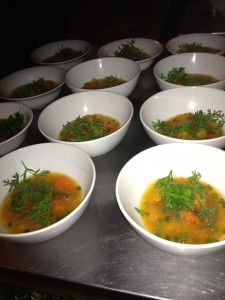 Course Two
 Course Three
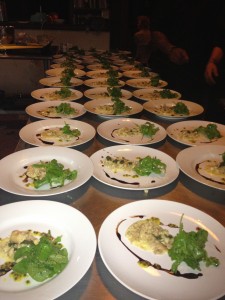 Course Four
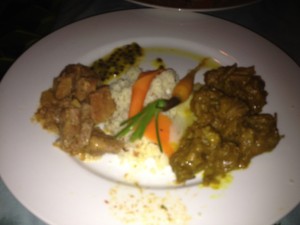 Course Five
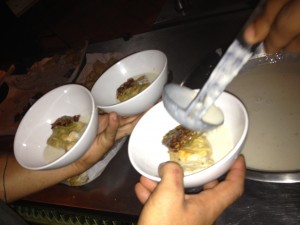 Course Six
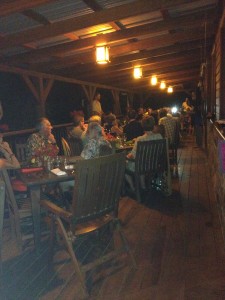 Everyone having a great time
Now that my internship at the City of Markham is complete, it’s hard to believe six weeks flew by so quickly. When I look at the variety and range of projects, meetings, and events I participated in it’s hard to believe it was only six weeks. The staff at the Markham Sustainability Office were a delight, welcoming me on very short notice and providing me a window on the range of activities coordinated through this small office.
My final two projects at the Sustainability Office were easily my favorites. The first was a summary and report on COLAB: A Change Lab for Markham; this book is the final report of a post-graduate certificate class in Interdisciplinary Design Solutions. The book lays out the nature and future of a change lab within the Markham municipal structure, a design solutions unit capable of tackling the big design issues in the City. COLAB would be a multi-partner entity, engaging and recruiting in the municipal, community, and private sectors. It is intended to be pursued as a pilot project for three years, hopefully becoming permanent going forward.
My other project was more concrete in application. Markham’s Greenprint sustainability plan includes 244 recommendations for becoming a sustainable city. A year after publication of the Greenprint, the City is seeking to evaluate its progress and gaps in pursuing those recommendations; this is where the Greenprint Inventory comes in. Using an Action Matrix to track all complete, ongoing, and planned actions the Sustainability Office engages with each municipal department for updates and feedback. My role was to follow up on the basically-complete Action Matrix by identifying gaps and opportunities for the short- and long-term.
That’s the story for now. It’s time to sit down and draft my report.
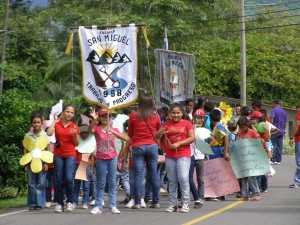 Rosina, one of my 6th grade students, holds the banner for the San Miguel school as they march down the street in La Mesa. Wednesday our English classes were cancelled at the school because the students were participating in the Desfile Ecologico, March for Ecology, in the neighboring town of La Mesa, Panama. The Community Outreach interns woke up early and headed down to the bus stop in San Miguel to travel to La Mesa to watch. While we were sitting waiting for our bus we saw the San Miguel students come down the stairs of the school across the street and board their own bus with drums and banners ready for the parade. Finally our bus came and when we arrived in La Mesa the parade had already begun. We hurried to catch up with the students, smiled proudly, and took photos as they marched by.
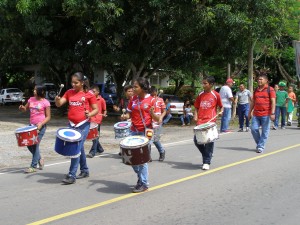 San Miguel's drummers. These students are in my 5th and 6th grade English class. The sound of the drums was overwhelming. Each school had their own drum core and one school was marching playing xyzlophones. Students were dressed in costumes and carried banners that conveyed messages about protecting the environment. Here are photos of some of my favorite banners from the parade.
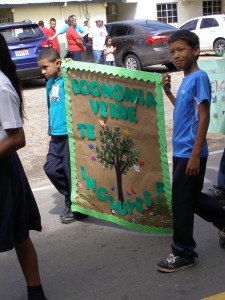 The banner reads - Economica verde te incluyen arboles. This translates to - A green economy will include the trees. 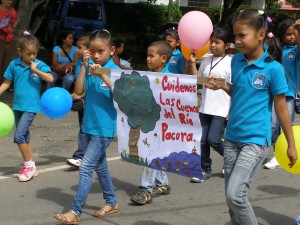 The banner reads - Cuidemos la cuenca del Rio Pacora. This translates to - Care for the river basin Pacora. 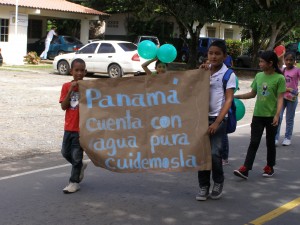 This banner reads - Panamá cuenta con agua para cuidemos. This translates to - Panama has to not waste water. The parade kept going and we were led into the meeting hall next to the soccer field in the center of town. We were invited inside by a man who was walking in the parade next to a banner about Dengue Fever and was passing out informational fliers. He turned out to be one of the speakers later in the program. We we escorted to seats on the floor while the students sat on bleachers and watched students dance, a singer and guitar duo perform a song about conservation, and an award was presented to the school who won the art contest.
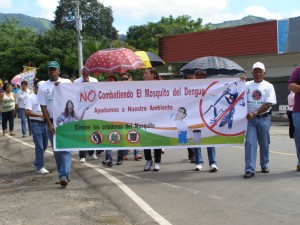
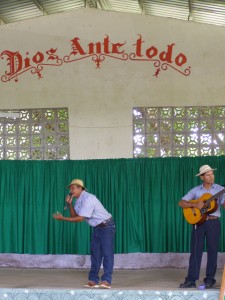
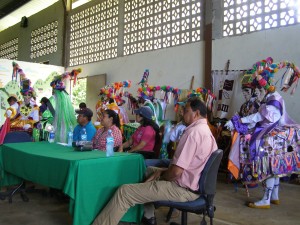 The representantes, or political leaders, of participating districts sit at the green table watching the performance on stage. 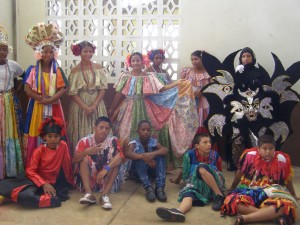 Dancers in elaborate costumes.
Let me tell you an interesting story about the day I met Señor Ruti.
Who is Señor Ruti you might ask?
He is the manager of the water treatment plant in La Mesa, Panama. Our paths crossed one Monday morning when I stopped in La Mesa to try to figure out the source of the water at the Casa Llena house in San Miguel.
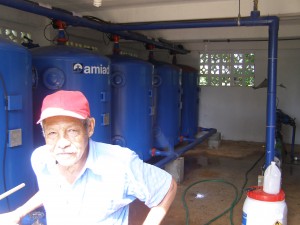 Señor Ruti inside the water treatment plant in La Mesa, Panama. This particular Monday morning I woke up with the sunrise in Panama City at Kalu Yala’s apartment in Parque Urraca and took the MetroBus toward 24 de Deciembre. In the town of 24 de Deciembre I exited the bus and paid for a taxi to take me up into the mountains toward San Miguel. My plan was to stop in La Mesa along the way to find information about the source of water at Casa Llena. I had been told to inquire at the police station in La Mesa because they helped past Kalu Yala interns and directors with questions.
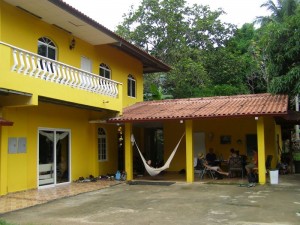 Our house in San Miguel, se llama Casa Llena. My main problem at this point was that nobody knew exactly where the water at our house came from. I had been told two different things. A past Kalu Yala director thought that the water was on a municipal supply from IDAAN. People in the town of San Miguel told me that their water comes from a water source, an arroyo or stream, or an ojo de agua or mountain spring, up toward the top of the mountain. This confused me. I did not think we were on municipal supply because every time it rains the water from the tap turns brown with sediment.
Through research I found out that IDAAN does not run service to San Miguel. There is municipal water in 24 de Deciembre but the water where we live in San Miguel is agua rural. This was confirmed on my second stop in La Mesa on the Monday I met Señor Ruti.
My first stop was the police station. I showed the 2 officers inside the address from the power bill and they told me we were agua rural and then directed me to another building down the street. Our street address reads, a lado del rio, which translates to next to the river.
Inside the second building I spoke with 2 women who confirmed that our water is agua rural. They explained that water sources for towns in the area can come directly from the Pacora River or be collected uphill, or arriba, from tributaries or mountain springs. All of this water, treated or untreated, is then stored in a tank. They suggested I go and talk with the teacher that speaks English at the primary school across the street. So I walked across the street, taxi driver Carlos in tow, and had a conversation with Leidelin Rodriguez, a teacher at the La Mesa Elementary School. She was telling me that La Mesa had its own water treatment plant up the hill when she looked over and saw Señor Ruti sitting on the bench at the entrance to the school. She pointed to him, told me who he was, and asked if I would like for her to ask if he would take me to the plant and show me around. We walked over to him, had a brief conversation, and moments later three of us were in the the cab headed up the street to have a look. Leidelin had to stay back at the school to teach. Here is what I found.
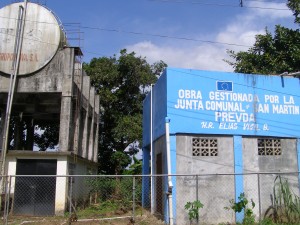 The water treatment plant in La Mesa consists of 2 buildings, I toured the one on the left. 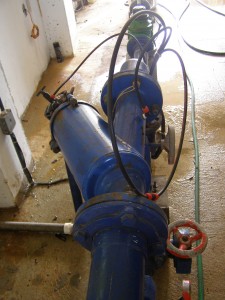 Primary filter system, dirty water is sent back to the river through the pipe on the left side of the photo. 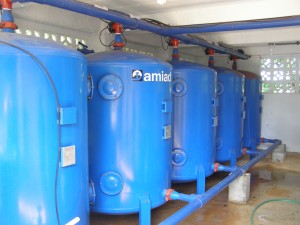 Five sand filters clean the water after bleach is added. 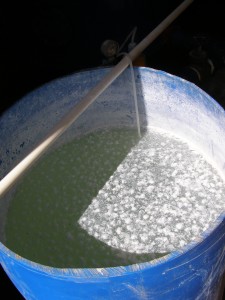 The bleach vat. 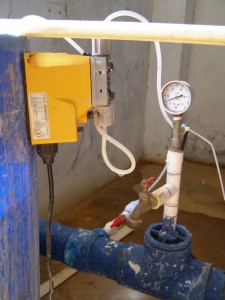 A pressurized pump measures the bleach and adds it to the water.
|
|

